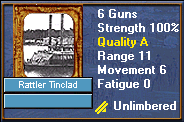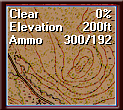Firing
Firing occurs as a result of the firing action by a player or the AI or under the control of the computer as Opportunity Fire. This Opportunity Fire gives a side a chance to fire on the enemy before being fired upon and being engaged in melee. It therefore represents the ability of the defender to have "first fire". Opportunity Fire is subject to the normal restrictions of firing including facing. However, it is possible for units with Low Ammo to use Opportunity Fire
How To Fire
To fire on the enemy, first Select the firing units. As a convenience, you may include Leaders in this selection although they have no effect on fire. Long press on the location of the units and release. Following that, tap on the target hex to fire.
Firing effectiveness depends on the Weapon Type of the firing unit, the range from the firing unit to the target hex, the Fatigue of the firing unit, and the Quality of the firing unit.
Facing Restrictions
A
unit must be facing the target unit before it can fire. A unit faces
one of 6 hex sides represented by the facings "Up ",
"Up-Right", "Down-Right", "Down ",
"Down-Left", and "Up-Left". For each facing
there are two other frontal hexsides which are adjacent to the facing
hexside. The target unit must be within the area determined by these
three hexsides.
Formation Restrictions
Infantry in Column, Mounted Cavalry, and Limbered Artillery cannot fire.
Range and Line of Sight Limitations
A target unit must be within range before it can be fired upon. The Unit List display shows you the range of a unit. In addition, the target unit must be within the Line of Sight of the firing unit.
Movement Restriction
With one exception, artillery cannot fire after moving in the same turn. This applies to both movement between hexes and turning in the same hex. However, under the optional Retire by Prolonge rule, an artillery unit can fire after retiring by prolonge.
Firing Fire Modifiers
The following modifiers are applied to the firing unit.
Disrupted units fire at 50% effectiveness.
Units that are constructing Breastworks or Trenches fire at 50% effectiveness
If the Firing Quality Modifier Optional Rule is in effect, a unit has 10% added to its fire value if it has a Quality of A or B, and 10% is subtracted from its fire value if it has a Quality of E or lower.
Fatigue modifiers apply as described in the section on Fatigue.
Opportunity Fire occurs at 50% effectiveness.
Target Fire Modifiers
The following modifiers are applied to the target of ranged fire.
Target units which have not moved during their turn get a defensive benefit from certain hexsides. The actual benefit is determined by Parameter Data and can be found by using the Parameter Data option of the Help menu .
Target units may get a defensive benefit from the terrain of the hex they are in. The benefit is shown in the Terrain Info box of the Unit List.
The target unit receives a defensive benefit when it is at a higher elevation than the firing unit. This benefit is normal for a single elevation change and is doubled for any elevation change of 2 increments or more. The actual value of this benefit can be found in the Parameter Data .
A unit in Line formation that is fired upon by a firing unit that it is not facing is subject to an Enfilade fire modifier. The value of this modifier is in the Parameter Data.
The Enfilade fire modifier also applies to any fire against Infantry in Column or Limbered Artillery.
When the target unit is in Abatis, behind Breastworks, or in a Trench Hex, a modifier determined by Parameter Data is applied.
Fire against a Cavalry unit may be modified by the Cavalry Fire Modifer Parameter Data value.
Fire Casualties
Fire casualties are calculated using the standard Combat Results based on the effective fire value of the firing unit with a Low Combat Value of 5 and a High Combat Value of 25.
Example: Suppose an Infantry Unit of 340 men equipped with Rifles fires at an enemy infantry unit 1 hex away. The standard range effectiveness of a Rifle at range 1 is 4. Thus the standard fire value for the unit would be 1360 (=340 x 4). The low end combat result would be 6.8 (= 5 * 1360 / 1000) and the high end combat result would be 34 (= 25 * 1360 / 1000). The actual combat result would be randomly determined between these two extremes. Randomly based on the fractional part of the actual combat result, the combat result is truncated up or down. This if the actual combat result was calculated to be 23.4, then this would determine a combat loss of 23 men 60% of the time and a loss of 24 men 40% of the time.
Bridge Damage
 A Bridge that is not occupied can be fired upon by Artillery and meleed
against by Infantry and Cavalry. The purpose of this is to provide a
means for destroying bridges in the game. The combat results from
melees are only applied to the Bridge and not the attacking forces.
When the strength of the Bridge is reduced to 0, then the Bridge
cannot be crossed. Under the optional Bridge Limit and Repair rule,
the rule for crossing bridges is changed and the ability to repair
bridges is supported (see the Movement section).
A Bridge that is not occupied can be fired upon by Artillery and meleed
against by Infantry and Cavalry. The purpose of this is to provide a
means for destroying bridges in the game. The combat results from
melees are only applied to the Bridge and not the attacking forces.
When the strength of the Bridge is reduced to 0, then the Bridge
cannot be crossed. Under the optional Bridge Limit and Repair rule,
the rule for crossing bridges is changed and the ability to repair
bridges is supported (see the Movement section).
Cavalry Rules
Dismounted Cavalry fires at ¾ effectiveness to account for the horse holders.
Indirect Fire

Gunboats and certain weapons such as mortars can fire at hexes that are not visible from their location. However, when they do this, the fire is subject to a random scatter from the target hex of up to 2 hexes in any direction.
To determine which units can fire indirect, long press on the unit picture. Units with an Indirect Fire capability will have the words Indirect Fire in the unit picture display.
Artillery Ammunition

Normally artillery ammunition is provided in a scenario based the number of batteries in the scenario for each side. In the Terrain Info box, the amount of artillery ammunition is displayed with the Union value first and the Confederate value second. As each artillery battery fires, this amount is reduced for that side by one. During opportunity fire, the value will decrease by one only half the time on average however. When artillery arrives as a reinforcement, then the value will increase representing the ammo that arrives with each battery. Supply Wagons have no affect on artillery ammunition and are only used to provide small arms ammunition to infantry and cavalry.
Under the Artillery Ammo by Cannon optional rule, artillery ammunition and usage is computed on a per-cannon basis instead of a per-battery basis. All other rules concerning artillery ammunition remain the same.
Other Fire Modifiers and Effects
Units which fire after movement in the current Turn do so at half effectiveness.
Units which are Low On Ammo cannot be commanded to fire (They can only Opportunity Fire).
Units which do not fire in the Turn receive a 10% bonus to the melee strength if they attack in the current Turn.
